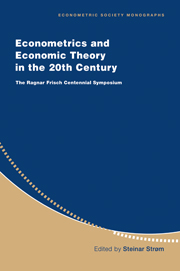Book contents
- Frontmatter
- PART I RAGNAR FRISCH AND HIS CONTRIBUTIONS TO ECONOMICS
- PART II UTILITY MEASUREMENT
- PART III PRODUCTION THEORY
- 6 Production Functions: The Search for Identification
- 7 Investment and Growth
- PART IV MICROECONOMIC POLICY
- PART V ECONOMETRIC METHODS
- PART VI MACRODYNAMICS
- PART VII MACROECONOMIC PLANNING
- Author Index
- Subject Index
6 - Production Functions: The Search for Identification
from PART III - PRODUCTION THEORY
Published online by Cambridge University Press: 05 January 2013
- Frontmatter
- PART I RAGNAR FRISCH AND HIS CONTRIBUTIONS TO ECONOMICS
- PART II UTILITY MEASUREMENT
- PART III PRODUCTION THEORY
- 6 Production Functions: The Search for Identification
- 7 Investment and Growth
- PART IV MICROECONOMIC POLICY
- PART V ECONOMETRIC METHODS
- PART VI MACRODYNAMICS
- PART VII MACROECONOMIC PLANNING
- Author Index
- Subject Index
Summary
We have here one of those cases - so frequent in economic practice - where it can be “proved” by abstract reasoning that a solution is not possible, but where life itself compels us nevertheless to find a way out.
Frisch (1934, p. 274)Introduction
Econometric production functions, as we know them today, originated in the work of Douglas (Cobb and Douglas, 1928). They started out as tools for testing hypotheses about the workings of marginal-productivity theory and the competitiveness of labor markets, using macroeconomic data. After a number of withering attacks by critics, this line of work shifted from macroeconomic data to microeconomic data, especially in agriculture (e.g.,Tintner, 1944; Mundlak, 1961; Heady and Dillon, 1961), where the assumptions necessary for estimating something sensible appeared to be more plausible. The increasing interest in growth and technological change brought production functions back as a measurement framework for productivity at the macroeconomic level. An important “dual” literature on cost functions, factor-demand systems, and flexible functional forms emerged somewhat later, but we shall comment on it only in passing here; see Jorgenson (1986) for a review. Both approaches have undergone significant econometric questioning, focused primarily on whether or not the relationship of interest has really been identified or is even identifiable with the data at hand.
- Type
- Chapter
- Information
- Econometrics and Economic Theory in the 20th CenturyThe Ragnar Frisch Centennial Symposium, pp. 169 - 203Publisher: Cambridge University PressPrint publication year: 1999
- 49
- Cited by

